International participation in the Vietnam War
The Vietnam War involved many countries across the world. North Vietnam received support from the Eastern Bloc, while South Vietnam was generally supported by nations of the Western Bloc.
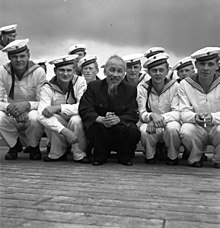
Pro-Hanoi
[edit]China
[edit]In 1950, the People's Republic of China extended diplomatic recognition to the Democratic Republic of Vietnam and sent heavy weapons, as well as military advisers led by Luo Guibo to assist the Viet Minh in its war with the French. The first draft of the 1954 Geneva Accords was negotiated by French prime minister Pierre Mendès France and Chinese Premier Zhou Enlai who, seeing U.S. intervention coming, urged the Viet Minh to accept a partition at the 17th parallel.[1]: 54–55
2,000 years of Chinese-Vietnamese enmity and hundreds of years of Chinese and Russian mutual suspicions were suspended when they united against us in Vietnam.
— Richard Holbrooke, 1985[2]
China's support for North Vietnam when the U.S. started to intervene included both financial aid and the deployment of hundreds of thousands of military personnel in support roles. In the summer of 1962, Mao Zedong agreed to supply Hanoi with 90,000 rifles and guns free of charge. Starting in 1965, China sent anti-aircraft units and engineering battalions to North Vietnam to repair the damage caused by American bombing, man anti-aircraft batteries, rebuild roads and railroads, transport supplies, and perform other engineering works. This freed North Vietnamese army units for combat in the South. China sent 320,000 troops and annual arms shipments worth $180 million.[1]: 135 The Chinese military claims to have caused 38% of American air losses in the war. China claimed that its military and economic aid to North Vietnam and the Viet Cong totaled $20 billion (approx. $160 billion adjusted for inflation in 2022) during the Vietnam War. Included in that aid were donations of 5 million tons of food to North Vietnam (equivalent to North Vietnamese food production in a single year), accounting for 10–15% of the North Vietnamese food supply by the 1970s.[citation needed]
Sino-Soviet relations soured after the Soviets invaded Czechoslovakia in August 1968. In October, the Chinese demanded North Vietnam cut relations with Moscow, but Hanoi refused.[3] The Chinese began to withdraw in November 1968 in preparation for a clash with the Soviets, which occurred at Zhenbao Island in March 1969.[4]
In 1967, the Chinese government launched a secret military program named "Project 523". which intended to find a treatment for malaria to provide the assistance to the PAVN who suffered malaria. As a result, Chinese scientist Tu Youyou and her collaborators discovered artemisinin. Tu was awarded the Nobel Prize in 2015 for her contribution on the anti-malaria treatment.
The Chinese also began financing the Khmer Rouge as a counterweight to North Vietnam at this time. China "armed and trained" the Khmer Rouge during the civil war and continued to aid them for years afterward.[5] The Khmer Rouge launched ferocious raids into Vietnam in 1975–1978. When Vietnam responded with an invasion that toppled the Khmer Rouge, China launched a brief, punitive invasion of Vietnam in 1979.
Soviet Union
[edit]
Prior to 1967, the Soviet Union provided military assistance by assisting North Vietnamese air force personnel.[6]
Soviet ships in the South China Sea gave vital early warnings to PAVN/VC forces in South Vietnam. The Soviet intelligence ships would pick up American B-52 bombers flying from Okinawa and Guam. Their airspeed and direction would be noted and then relayed to the Central Office for South Vietnam, North Vietnam's southern headquarters. Using airspeed and direction, COSVN analysts would calculate the bombing target and tell any assets to move "perpendicularly to the attack trajectory." These advance warnings gave them time to move out of the way of the bombers, and, while the bombing runs caused extensive damage, because of the early warnings from 1968 to 1970 they did not kill a single military or civilian leader in the headquarters complexes.[7] Further assistance was also extended to helping North Vietnam develop anti-US propaganda posters.[6]
The Soviet Union supplied North Vietnam with medical supplies, arms, tanks, planes, helicopters, artillery, anti-aircraft missiles and other military equipment. Soviet crews fired Soviet-made surface-to-air missiles at U.S. F-4 Phantoms, which were shot down over Thanh Hóa in 1965. Over a dozen Soviet soldiers lost their lives in this conflict. Following the dissolution of the Soviet Union in 1991, Russian Federation officials acknowledged that the Soviet Union had stationed up to 3,000 troops in Vietnam during the war.[8]

Some Russian sources give more specific numbers: Between 1953 and 1991, the hardware donated by the Soviet Union included 2,000 tanks, 1,700 APCs, 7,000 artillery guns, over 5,000 anti-aircraft guns, 158 surface-to-air missile launchers, and 120 helicopters. During the war, the Soviets sent North Vietnam annual arms shipments worth $450 million.[9]: 364–371 From July 1965 to the end of 1974, fighting in Vietnam was observed by some 6,500 officers and generals, as well as more than 4,500 soldiers and sergeants of the Soviet Armed Forces. In addition, Soviet military schools and academies began training Vietnamese soldiers—in all more than 10,000 military personnel.[10]
The KGB also helped develop the signals intelligence (SIGINT) capabilities of the North Vietnamese, through an operation known as Vostok (also known as Phương Đông, meaning "Orient" and named after the Vostok 1).[11] The Vostok program was a counterintelligence and espionage program. These programs were pivotal in detecting and defeating CIA and South Vietnamese commando teams sent into North Vietnam, as they were detected and captured.[11] The Soviets helped the Ministry of Public Security recruit foreigners within high-level diplomatic circles among the Western-allies of the US, under a clandestine program known as "B12,MM" which produced thousands of high-level documents for nearly a decade, including targets of B-52 strikes.[11] In 1975, the SIGINT services had broken information from Western US-allies in Saigon, determining that the US would not intervene to save South Vietnam from collapse.[11]
Other Communist states
[edit]Czechoslovakia
[edit]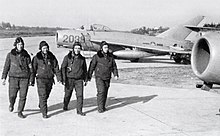
The Czechoslovak Socialist Republic was a member of the Warsaw Pact and sent significant aid to North Vietnam, both prior to and after the Prague Spring.[13] The Czechoslovakian government created committees which sought to not only promote and establish peace, but also to promote victory for Viet Cong and PAVN forces.[13] Czech-made equipment and military aid would increase significantly following the Prague Spring.[14] Czechoslovakia continued to send tens of thousands of Czech-made rifles as well as mortar and artillery throughout the war.[14] In general, Czechoslovakia was aligned with European leftist movements,[13] and there were simultaneous protests demonstrating against the Soviet intervention in Prague and the US intervention in Vietnam.[15]
Cooperation with Czechoslovakia on the development of North Vietnamese air capabilities began as early as 1956.[16] Czechoslovak instructors and trainers instructed the Vietnam People's Air Force (VPAF) in China and helped them develop a modernised air force, with the Czech-built Aero Ae-45 and Aero L-29 Delfín alongside Zlín Z 26 aircraft utilised significantly for training, and regarded as preferential to Soviet-built Yakovlev Yak-3 as training aircraft.[16]
North Korea
[edit]As a result of a decision of the Korean Workers' Party in October 1966, in early 1967, North Korea (officially known as Democratic People's Republic of Korea) sent a Korean People's Army Air Force fighter squadron to North Vietnam to back up the North Vietnamese 921st and 923rd Fighter Squadrons defending Hanoi. The North Koreans stayed through 1968, and 200 pilots were reported to have served. In addition, at least two anti-aircraft artillery regiments were sent as well.[17]
Cuba
[edit]
The contributions to North Vietnam by the Republic of Cuba under Fidel Castro have been recognized several times by representatives of the Democratic Republic of Vietnam.[18] Castro mentioned in his discourses the Batallón Girón (Giron Battalion) as comprising the Cuban contingent that served as military advisors during the war.[19][20] In this battalion, the Cubans were aided by Nguyễn Thị Định, founding member of the Viet Cong, who later became the first female major general in the PAVN.[21]
There are numerous allegations by former U.S. prisoners of war that Cuban Revolutionary Armed Forces personnel were present at North Vietnamese prison facilities during the war and that they participated in torture activities. Witnesses to this include Senator John McCain, the 2008 U.S. presidential candidate and a former Vietnam prisoner of war, according to his 1999 book Faith of My Fathers.[22]
East Germany
[edit]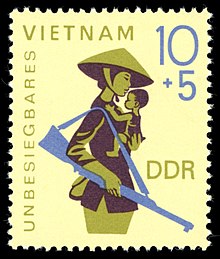
The Ministry of Public Security of Vietnam (Bộ Công An) states that there was special interest towards the Stasi of East Germany in establishing an intelligence and security apparatus, particularly since the Stasi was well-regarded and considered as "industrial, modern, and (with a) scientific working-style".[23] In official Vietnamese language histories on the Vietnamese Ministry of Public Security, the assistance provided by the Soviet and East German intelligence services to Vietnam is usually rated as the most important within the socialist bloc.[23] East Germany had also provided a substantial amount of aid to help North Vietnam duplicate "Green Dragon" identity cards, which were created by Saigon in order to identify North Vietnamese combatants and were difficult to duplicate.[23]
East German authorities had also begun providing material and technical aid to help develop and modernise the North Vietnamese economy and military.[23] In addition, East Germany had also vigorously denounced the US war effort, and had reaped significant international and diplomatic standing as a result of its anti-war campaigns.[24]
Romania
[edit]Romania was also among primary supporters of North Vietnam during the war in political, economic and military terms. Contemporarily, the Eastern Bloc country was also known for its role in the mediation activities in the mid-1960s, resulting in what became known as the "Trinh Signal" in January 1967, in which Hanoi accepted the possibility of negotiation with Washington.[25]
Bulgaria
[edit]Bulgaria committed their charge-free military and economic supplies to North Vietnam in a bilateral agreement signed in 1972. Bulgarian military aid had already been provided to the latter since 1967. Similar conducts was undertaken by Hungary, which was reaffirmed in mutual visits of Hungary and North Vietnam in 1972 and 1973.
Hungary
[edit]Hungary also expressed their support through their representatives at the International Commission of Control and Supervision, a body established to supervise the implementation of the Paris Peace Accords.[26][page needed]
Pro-Saigon
[edit]As South Vietnam was formally part of a military alliance with the US, Australia, New Zealand, France, the UK, Pakistan, Thailand and the Philippines, the alliance was invoked during the war. The UK, France and Pakistan declined to participate, and South Korea and Taiwan were non-treaty participants.
United States
[edit]This section needs expansion. You can help by adding to it. (November 2022) |
Others
[edit]South Korea
[edit]On the anti-communist side, South Korea (a.k.a. the Republic of Korea, ROK) had the second-largest contingent of foreign troops in South Vietnam after the United States. In November 1961, President Park Chung Hee proposed South Korean participation in the war to John F. Kennedy, but Kennedy disagreed as they were not SEATO treaty members.[27] On 1 May 1964, Lyndon Johnson agreed to permit South Korean participation under the Many Flags Program in return for monetary compensation.[27] The first South Korean troops began arriving in 1964 and large combat formations began arriving a year later. The ROK Marine Corps dispatched their 2nd Marine Brigade, while the ROK Army sent the Capital Division and later the 9th Infantry Division. In August 1966, after the arrival of the 9th Division, the Koreans established a corps command, the Republic of Korea Forces Vietnam Field Command, near I Field Force at Nha Trang.[28]
State Department reports publicly questioned the usefulness of ROK forces in the conflict, as they have "appeared to have been reluctant to undertake offensive operations, and are only useful in guarding a small sector of the populated area".[29] State department reports furthermore state that ROK forces engaged in systemic, well-organised corruption in diverting US-equipment, and that actual security was often provided by South Vietnamese Regional Forces, which lacked organic firepower and heavy artillery but served as a buffer between Korean units and the PAVN/VC.[30] In addition, a RAND author conducting studies in South Vietnam in 1970 alleged that ROK forces had a "deliberate, systematic policy of committing atrocities", prompting civilians to leave ROK-controlled sectors.[31] The conduct of ROK forces often emboldened and strengthened the Viet Cong, adding ranks from an otherwise neutral population and undermining efforts to defeat the insurgency overall.[32]
Approximately 320,000 South Korean soldiers were sent to Vietnam,[33] each serving a one-year tour of duty. Maximum troop levels peaked at 50,000 in 1968, however all were withdrawn by 1973.[34] About 5,099 South Koreans were killed and 10,962 wounded during the war. South Korea claimed to have killed 41,000 Viet Cong.[33][35] The United States paid South Korean soldiers 236 million dollars for their efforts in Vietnam,[33] and South Korean GNP increased five-fold during the war.[33]
Thailand
[edit]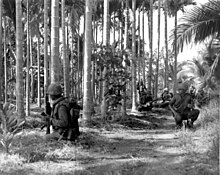
Thai Army formations, including the Royal Thai Volunteer Regiment (Queen's Cobras) and later the Royal Thai Army Expeditionary Division (Black Panthers), saw action in South Vietnam between 1965 and 1971. Thai forces saw much more action in the covert war in Laos between 1964 and 1972, though Thai regular formations there were heavily outnumbered by the irregular "volunteers" of the CIA-sponsored Police Aerial Reconnaissance Units or PARU, who carried out reconnaissance activities on the western side of the Ho Chi Minh trail.
From 1961 to 1975, the United States Air Force (USAF) conducted strikes into North Vietnamese territory from Royal Thai Air Force bases. These airbases include:[36]
Australia and New Zealand
[edit]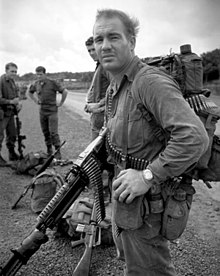
Australia and New Zealand, close allies of the United States and members of the SEATO and the ANZUS military cooperation treaty, sent ground troops to Vietnam. Both nations had gained experience in counterinsurgency and jungle warfare during the Malayan Emergency and World War II, and their governments subscribed to the domino theory. New Zealand was, however, a reluctant participant. Officials expected a foreign intervention to fail, were concerned that they would be supporting a corrupt regime, and did not want to further stretch their country's small military (which was already deployed to Malaysia).[37] In the end, though, a desire to prove their commitment to the ANZUS alliance and discourage an American withdrawal from Southeast Asia necessitated a military commitment. Australia began by sending advisors to Vietnam in 1962, and combat troops were committed in 1965.[38]: 555–558 New Zealand began by sending a detachment of engineers and an artillery battery, later sending special forces and regular infantry, which were attached to Australian formations.[39]: 561–566 Australia's peak commitment was 7,672 combat troops and New Zealand's 552. Around 50,190 Australian Defence Force personnel were involved during the war, of which 521 were killed and more than 3,000 wounded.[40] Approximately 3,500 New Zealand Defence Force personnel served in Vietnam, with 37 killed and 187 wounded.[39]: 539 Most Australians and New Zealanders served in the 1st Australian Task Force in Phước Tuy Province.[38]
Australia, with decades of experience from both the Malayan Emergency and its AATTV role in 1962, recognised the necessity of a true counter-insurgency, which relied on providing village-level security, establishing civilian trust and economic incentives and improving ARVN capabilities.[41] This brought Australian commanders into conflict with Westmoreland's conventional attrition warfare approach, since Australian ground forces were required to follow US doctrine.[41] Nevertheless, Australian forces were generally the most capable at counter-insurgency, and they helped to train Regional Forces despite being under significant doctrinal constraints.[41]
Philippines
[edit]Some 10,450 Philippine Armed Forces troops were dispatched to South Vietnam and primarily supported medical and other civilian pacification projects. These forces operated under the designation A or Philippine Civic Action Group-Vietnam. The naval base at Subic Bay was used for the U.S. Seventh Fleet from 1964 until the end of the war in 1975.[42][43] Subic Bay and Clark Air Base achieved maximum functionality during the war, as well as supporting an estimated 80,000 locals in allied tertiary businesses that ranged from shoe making to prostitution.[44]
Taiwan
[edit]Beginning in November 1967, Taiwan secretly operated a cargo transport detachment to assist the United States and South Vietnam. Taiwan also provided military training units for the South Vietnamese diving units, later known as the Lien Doi Nguoi Nhai (LDMN) or "Frogman unit" in English.[45]: 3–4 Military commandos from Taiwan were captured by North Vietnamese forces three times trying to infiltrate North Vietnam.[45]: 3–4
Neutral and non-belligerent nations
[edit]Canada
[edit]Contributor to the three-nation monitoring-force, the International Control Commission (ICC/ICSC) [1954–1973] and, briefly, its successor: the International Commission for Control and Supervision (ICCS) [1973-1973].[46] Officially, Canada, in spite of having been a NATO member since 1949, did not have state-sanctioned combat involvement in the Vietnam War, and diplomatically, it was "non-belligerent", though the sympathies of the state and many of its citizens were well-understood by both sides.[47] The Vietnam War entry in The Canadian Encyclopedia asserts that Canada's record on the truce commissions was a pro-Saigon partisan one.[48] Under Prime Minister Pierre Trudeau, Immigration and Citizenship Canada notably accepted approximately 40,000 American draft evaders and military deserters as legal immigrants despite U.S. pressure.[49] At the same time, approximately 20,000 to 40,000 Canadians crossed the U.S.-Canada border to illegally enlist in the U.S. Armed Forces for service in Vietnam, of whom at least 134 died.[50]
United Kingdom
[edit]The Johnson administration was anxious to secure a military commitment from Britain, which the United States was closely allied with through NATO and the Special Relationship. The United States had previously cancelled its planned air intervention at the end of the First Indochina War because of doubts from British Prime Ministers Winston Churchill and Anthony Eden. McNamara and Bundy joked that they would give a billion dollars for one British brigade. After the 1964 general election Johnson began lobbying the new Labour Prime Minister Harold Wilson for a small British Armed Forces deployment. However, the war was deeply unpopular in Britain and Wilson rebuffed Johnson's requests. The denial of military assistance slightly strained U.S.-U.K. relations in the 1960s.[51]
Poland
[edit]Contributor to the three-nation monitoring-force, the International Control Commission (ICC/ICSC) [1954–1973] and its successor: the International Commission for Control and Supervision (ICCS) [1973–1975]. The Polish People's Republic had played a substantive role in brokering and serving as an intermediary for peace-talks between Hanoi and Saigon, as part of a delegation under the International Control Commission established under the Geneva Accords. Recent evidence has emerged that Poland played an early role in attempting to broker talks between Ngô Đình Nhu and the Diem regime and Hanoi in 1963 in an effort to prevent the expansion of the war, given that Polish representatives were the only communist nation present in Saigon and had acted as a broker and representative for Hanoi.[52]
Spain
[edit]President Johnson had asked the Spanish Caudillo Francisco Franco to contribute a military contingent to the war effort. After lengthy debate between his ministers, Franco took the advice of veteran General Agustín Muñoz Grandes. Franco was even more cautious in committing himself to the US cause and finally decided to send a medical team of around thirty people, and under strict secrecy. The first group of medical soldiers, including four doctors, seven nurses and one officer in charge of military supplies, arrived in Vietnam in 1966 and worked at Truong Cong Dinh hospital in the Gò Công district. From 1966 to 1971 three other groups, totalling nearly 100 Spaniards, worked at the hospital.[53]
Brazil
[edit]Brazil, under a U.S.-backed military regime, officially supported the United States' position in South Vietnam and contributed a medical team and supplies to the country. It was the only Latin American country with a presence in the region.[54][55]
See also
[edit]- Cambodian Civil War
- First Indochina War § Foreign involvement
- Ho Chi Minh trail
- Laotian Civil War
- North Vietnamese invasion of Laos
References
[edit]- ^ a b Qiang, Zhai (2000). China and the Vietnam Wars, 1950–1975. University of North Carolina Press. ISBN 978-0-8078-4842-5.
- ^ Leslie H. Gelb (18 April 1985). "U.S. Power in Asia has Grown Since Vietnam". The New York Times.
- ^ Ang, Cheng Guan (2005). Ending the Vietnam War: The Vietnamese Communists' Perspective. Routledge Curzon. p. 27. ISBN 978-0-415-40619-2.
- ^ "CHINESE AND SOVIET INVOLVEMENT IN VIETNAM". 20 June 2019.
- ^ Bezlova, Antoaneta (21 February 2009). "China haunted by Khmer Rouge links". Asia Times. Archived from the original on 23 February 2009.
- ^ a b Guy D. McCardle (2024-07-10). "SOFREP Pic of the Day: Declassified CIA Photo of North Vietnamese Pilot Receiving Training From Soviet Instructors". Archived from the original on 2024-07-11. Retrieved 2024-07-11.
- ^ Truong, Nhu Tang; Chanoff, David; Doan, Van-Toai (1985). A Vietcong memoir. San Diego: Harcourt, Brace, Jovanovich. p. 168. ISBN 978-0-15-193636-6.
- ^ "Soviet Involvement in the Vietnam War". historicaltextarchive.com. Associated Press.
- ^ Sarin, Oleg; Dvoretsky, Lev (1996). Alien Wars: The Soviet Union's Aggressions Against the World, 1919 to 1989. Presidio Press. pp. 93–4. ISBN 978-0-89141-421-6.
- ^ "Soviet rocketeer: After our arrival in Vietnam, American pilots refused to fly" (in Russian). rus.ruvr. Archived from the original on 17 January 2013. Retrieved 26 May 2010.
- ^ a b c d Pribbenow, Merle (December 2014). "The Soviet-Vietnamese Intelligence Relationship during the Vietnam War: Cooperation and Conflict" (PDF). Archived from the original (PDF) on 12 April 2019. Retrieved 1 June 2018.
- ^ Toperczer, István (2017). MiG-21 Aces of the Vietnam War. Bloomsbury Publishing. ISBN 978-1-4728-2357-1.
- ^ a b c Bischof, Günter; Karner, Stefan; Ruggenthaler, Peter (2010). The Prague Spring and the Warsaw Pact Invasion of Czechoslovakia in 1968. Rowman & Littlefield. p. 293. ISBN 978-0-7391-4304-9.
- ^ a b Francev, Vladimir (2015). Československé zbraně ve světě: V míru i za války (in Czech). Grada Publishing. p. 166. ISBN 978-80-247-5314-0.
- ^ Kavan, Jan (July 2008). "Czechoslovakia 1968: Revolt or Reform? 1968 – A Year of Hope and Non-Understanding". Journal of Socialist Theory. 36 (2): 289. doi:10.1080/03017600802185415. S2CID 143974538.
- ^ a b Toperczer, István (2012). MiG-17 and MiG-19 Units of the Vietnam War. Bloomsbury Publishing. pp. 10–18. ISBN 978-1-78200-748-7.
- ^ Pribbenow, Merle (2003). "The 'Ology War: technology and ideology in the defense of Hanoi, 1967". Journal of Military History. 67 (1): 183. doi:10.1353/jmh.2003.0066.
- ^ "Vietnam agradece apoyo cubano durante guerra (Vietnam says thanks for Cuban support during the war, in Spanish)". Revista Vietnam. 13 December 2012. Retrieved 2 August 2015.
- ^ Castro, Fidel. "Cuba y Vietnam: discurso de Fidel Castro en apoyo del F.N.L. (Cuba and Vietnam, speech of Fidel Castro in support of Viet Cong, in Spanish)". Ruinas Digitales. Archived from the original on 1 September 2015. Retrieved 2 August 2015.
- ^ "Vietnam - Cuba: 60 years of historic friendship". En.nhandan.org.vn. Retrieved 11 April 2021.
- ^ "Cubanos y vietnamitas conmemoran aniversarios de victorias". Cuba Diplomática (Diplomatic Cuba). Embajada de Cuba en Vietnam (Cuban Embassy in Vietnam). Archived from the original on 2 September 2015. Retrieved 2 August 2015.
- ^ "Castro denies McCain's torture claim". MSNBC. 2 November 2008. Retrieved 2 November 2019.
- ^ a b c d Grossheim, Martin (September 2014). "The East German 'Stasi' and the Democratic Republic of Vietnam during the Vietnam War" (PDF). Wilson Center. Archived from the original (PDF) on 3 October 2018. Retrieved 6 June 2018.
- ^ Horten, Gerd (15 November 2013). "Sailing in the Shadow of the Vietnam War: The GDR Government and the "Vietnam Bonus" of the Early 1970s". German Studies Review. 36 (3): 557–578. doi:10.1353/gsr.2013.0114. ISSN 2164-8646. S2CID 159909822. Archived from the original on 3 January 2020. Retrieved 27 October 2022.
- ^ Deletant, Dennis (2018). Romania under Communism: Paradox and Degeneration. Routeledge. ISBN 978-1-138-70742-9.
- ^ Cooper, John F. (2019). Communist Nations' Military Assistance. Routledge. ISBN 978-0-429-72473-2.
- ^ a b Chang, Jae Baik (2011). The Park Chung Hee Era: The Transformation of South Korea. Harvard University Press. p. 409. ISBN 978-0-674-05820-0.
- ^ Stanton, Shelby L. (2003). Vietnam order of battle. Stackpole Books. ISBN 978-0-8117-0071-9.
- ^ Foreign Relations of the United States, 1969–1976, Volume XIX, Pt. 1, Korea, 1969–1972. Government Printing Office. p. 242. ISBN 978-0-16-087642-4.
- ^ Hunt, Richard A. (2015). Melvin Laird and the Foundation of the Post-Vietnam Military, 1969–1973. Government Printing Office. pp. 352–355. ISBN 978-0-16-092757-7.
- ^ Smith, Robert M. (1970). "Vietnam Killings Laid to Koreans". The New York Times. ISSN 0362-4331. Retrieved 31 May 2018.
- ^ Elliott, Mai (2010). RAND in Southeast Asia: A History of the Vietnam War Era. Rand Corporation. pp. 187–193. ISBN 978-0-8330-4915-5.
- ^ a b c d "1965년 전투병 베트남 파병 의결". Donga Ilbo. 2 July 2008. Retrieved 17 July 2011.
- ^ Leepson, Marc; Hannaford, Helen (1999). Webster's new world dictionary of the Vietnam War. Macmillan. p. 209. ISBN 978-0-02-862746-5.
- ^ Eighth US Army Chronology 1972 (PDF) (Report). pp. 22–24 – via Nautilus Institute for Security and Sustainability.
- ^ "Thailand | US Air Force Security Forces | Virtual Museum | Memorial | Military Police | USAF | SP | AP | SF". USAF Police Alumni Association. Retrieved 2023-03-18.
- ^ McKinnon, Malcolm (1993). Independence and Foreign Policy: New Zealand in the World Since 1935. Auckland, NZ: Auckland University Press. pp. 152–177.
- ^ a b Dennis, Peter (2008). The Oxford Companion to Australian Military History (Second ed.). Oxford University Press Australia & New Zealand. ISBN 978-0-19-551784-2.
- ^ a b McGibbon, Ian (2000). The Oxford Companion to New Zealand Military History. Oxford University Press. ISBN 978-0-19-558376-2.
- ^ "Vietnam War 1962–1972". Australian War Memorial. Archived from the original on 21 August 2008. Retrieved 1 July 2006.
- ^ a b c Ross, Brian (1995). "Australia's Military Involvement in the Vietnam War" (PDF). Vietnam Veterans of Australia Association.
- ^ Anderson, Gerald (2009). Subic bay: from Magellan to Pinatubo. CreateSpace Independent Publishing Platform. ISBN 978-1-4414-4452-3.
- ^ Karnow, Stanley (1990). In Our Image: America's Empire in the Philippines. Ballantine books. ISBN 978-0-345-32816-8.
- ^ Utts, Thomas (2006). GI Joe Doesn't Live Here Anymore: A History of Clark Air Base, America's Mighty Air Force Bastion in the Philippines. University of Michigan. ISBN 978-1-4137-7835-9.
- ^ a b Moïse, Edwin E. (1996). Tonkin Gulf and the Escalation of the Vietnam War. University of North Carolina Press. ISBN 978-0-8078-2300-2.
- ^ Edelgard, Elsbeth; Mount, Graeme S. (1999). Invisible and inaudible in Washington: American policies toward Canada. UBC Press. p. 50. ISBN 978-0-7748-0703-6.
- ^ "Quiet Complicity: Canadian Involvement in the Vietnam War". Review by The Manitoba Historical Society. Retrieved 15 July 2010.
- ^ "Vietnam War". The Canadian Encyclopedia. Archived from the original on 26 April 2012.
- ^ Valiante, Giuseppe; Press, The Canadian (16 April 2015). "U.S. Vietnam war draft dodgers left their mark on Canada". Macleans.ca. Retrieved 25 October 2021.
- ^ Corday, Chris (10 November 2015). "Lost to history: the Canadians who fought in Vietnam". CBC News. Retrieved 25 October 2021.
- ^ Hastings, Max (2018). Vietnam : an Epic Tragedy, 1945-1975 (First ed.). New York, NY: Harper. ISBN 978-0-06-240566-1. OCLC 1001744417.
- ^ Gnoinska, Margaret K. (March 2005). Ostermann, Christian F. (ed.). Poland and Vietnam, 1963: New Evidence on Secret Communist Diplomacy and the "Maneli Affair (Report). Cold War International History Project. CiteSeerX 10.1.1.401.5833. Working Paper #45.
- ^ Marín, Paloma (9 April 2012). "Spain's secret support for US in Vietnam". El Pais. Retrieved 30 April 2020.
- ^ Weil, Thomas E. (1975). Area Handbook for Brazil. p. 293.
- ^ Munhoz, Sidnei José; Silva, Francisco Carlos Teixeira da (2013). Brazil – United States relations: XX and XXI centuries. Editora da Universidade Estadual de Maringá – EDUEM. pp. 316–317. ISBN 978-85-7628-659-2.
